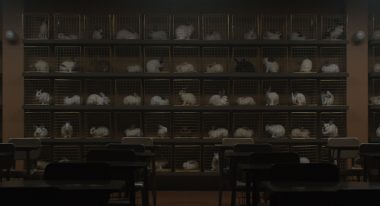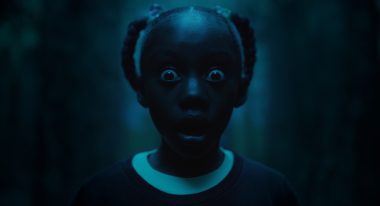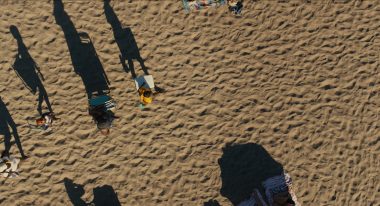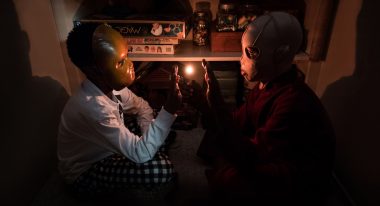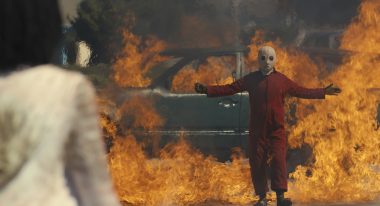 Back to selection
Back to selection
Shutter Angles
Conversations with DPs, directors and below-the-line crew by Matt Mulcahey
“There’s Something to Be Said for Eliminating Variables and Keeping Things Simplistic”: DP Mike Gioulakis on the Doppelgängers of Us
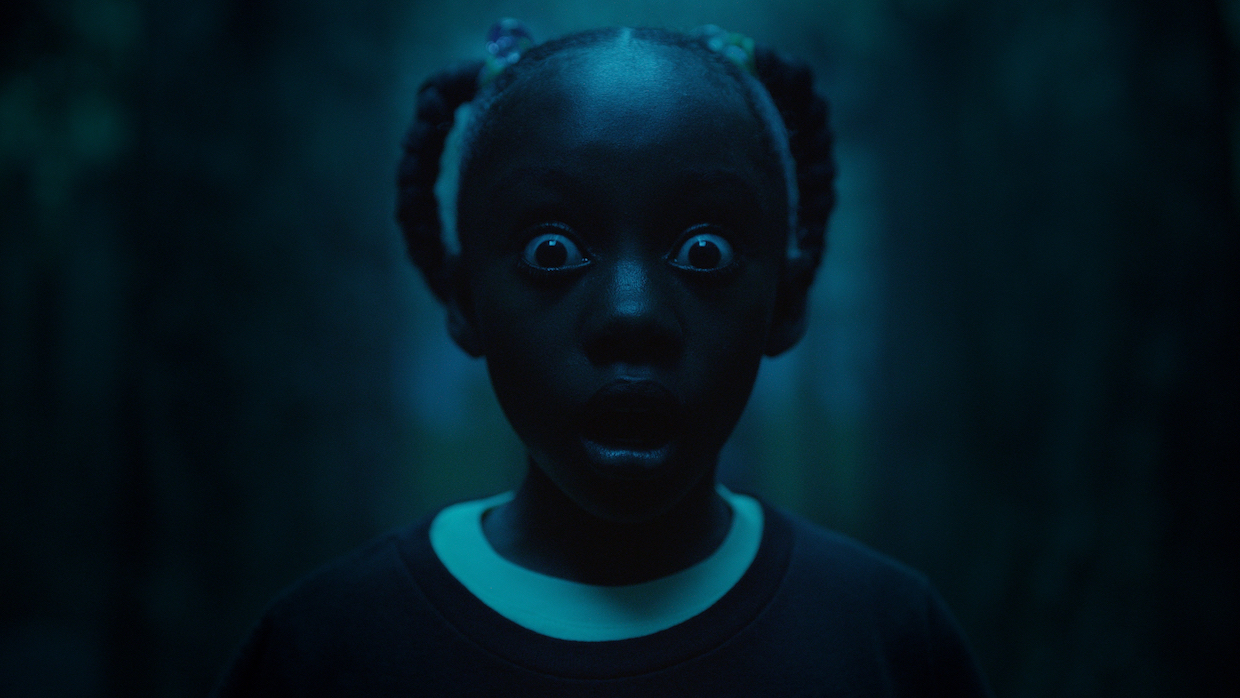 MAdison Curry in Us
MAdison Curry in Us In Jordan Peele’s Us, a middle class family returns home from a day at the beach to find themselves under siege by murderous doppelgängers clad in red jumpsuits and wielding scissors. Instead of leaning primarily on face replacements, compositing and other post production tricks, cinematographer Mike Gioulakis emphasized clever camera placement and the use of doubles to create the illusion of Lupita Nyong’o and her clan battling their alter egos.
With Us hitting Blu-ray and other home entertainment platforms last week, Gioulakis walked Filmmaker through some of the film’s most memorable shots.
Filmmaker: Since we spoke for It Follows, you’ve shot two M. Night Shyamalan movies (Split, Glass) and now Us for Jordan Peele. Have you always been a fan of horror or did It Follows inadvertently send you on that trajectory?
Gioulakis: I was never a huge horror movie person. Night saw It Follows and contacted me and I really liked working with him, then Jordan saw Split. So, yeah, it just kind of happened.
Filmmaker: It’s crazy how good Jordan Peele’s first two horror films (Get Out and Us) have been. It’s like if, when I was growing up, Dana Carvey suddenly directed Halloween and The Thing.
Gioulakis: (laughs) Yeah, Jordan is super talented.
Filmmaker: Get Out was unique, but there were some spiritual predecessors you could point to, namely The Stepford Wives. But I can’t really think of any corollaries for Us. Did Jordan want you to check out any particular films for visual inspiration?
Gioulakis: Jordan is inspired by a lot of different things so it was kind of a hodgepodge. I think the two films we talked about the most were Alien and Jaws. (The latter) had this tone that we were aiming for that mixes adventure, horror and comedy.
Filmmaker: Is Jordan a director who likes to storyboard?
Gioulakis: Jordan is very big on storyboards. We ended up storyboarding pretty much every shot in the movie. We did as much as we could in prep and then continued to do them throughout filming—reviewing and adjusting the boards before we started each day, during lunch and then after wrap. Jordan is a very visual person and I think laying the film out on strips was helpful for him, and I really like working that way too. But it was also helpful specifically for this movie because all the actors are playing another version of themselves as well. So the storyboards became our bible in terms of scheduling and knowing who was in which shot and how we were going to cover each scene. We had to be very specific about it, because the hair/make-up/wardrobe changes were roughly two hours for each person (to make them into their doppelgänger). So you couldn’t just be like, “Okay, now we’ll turn around quick and shoot (Lupita Nyong’o) Good Adelaide.”
Filmmaker: The second time I watched Us I was specifically looking for composites of actors playing their own doubles in the same shot. I may have missed a few, but I only picked out a couple of them. How much of that illusion is created through clever coverage, blocking and editing?
Gioulakis: There are only a handful of (composited) shots over the course of the film. We tried not to make a spectacle out of it or make it a gimmick.
Filmmaker: On It Follows you used the Cooke S4s and here you’re using the Arri/Zeiss Master Primes. So you like newer, cleaner glass?
Gioulakis: I did the S4s on It Follows probably because I couldn’t afford the Master Primes. Since then I’ve been using Master Primes on all my features. I do enjoy the clean look. There are so many beautiful movies that are shot on all sorts of vintage glass, but I personally feel like the cleaner the image is, the more immersive it is. All those distortions and things that can come with vintage lenses can be beautiful, but I feel like it can have an unconscious effect on an audience.
Filmmaker: My favorite cinematographer is Roger Deakins and all he’s used for years are the Master Primes and pretty much one LUT, which he’s had since Skyfall.
Gioulakis: That makes a lot of sense to me and he’s also one of my favorite cinematographers. There’s something to be said for eliminating variables and keeping things simplistic.
Filmmaker: What was your on-set color workflow like?
Gioulakis: In prep I created a LUT with a color scientist friend of mine, CJ Julian. I shot some tests and we tried to create a LUT that worked well for darker skin tones without having any kind of color cast in the lower end of the curve. Kind of similar to Deakins’ philosophy, I like just using one LUT and then creating different looks through lighting or what the production designer is putting in front of the camera. Then, in the DI, my colorist Michael Hatzer used the same LUT as a starting point.
Filmmaker: Did you expose brighter and then push it down in the DI?
Gioulakis: The LUT that I was using was a pretty dark LUT, so we were exposing a healthy negative, and then we had the room to bring it down without getting into too much trouble. It’s a dark movie and a big chunk of it takes place with the lights out, but I didn’t want it to feel like we were separately lighting the actors’ faces because of the darker skin tones. If it was dark and meant to be dark, Jordan was really on board with that. A lot of films I love from the 1970s and 1980s, movies like Klute, you can barely see anything in the frame.
Filmmaker: Let’s get into some specific shots, starting with the film’s opening credits, which unfold over a long pullback on caged bunnies.
Gioulakis: That was a tricky shot. Gear-wise, it was a simple jib and a stabilized head. We pulled the wall out from the classroom set and had maybe a 15-foot jib on track. We started on the very long end of the zoom—around 290mm—right at minimum focus and we were zooming and dollying back at the same time. Jordan had a temp version of the music cue from the composer, Michael Abels, so we were able to time the shot out to the cue. We did a couple rehearsals and got it in maybe three or four takes. Because of the framing and some of the bunny performances, they ended up using the first take in the movie. That was an incredibly hard focus pull, but our 1stAC Scott Johnson, who I’ve worked with on the past four films, got it rock solid on the first take.
Filmmaker: You used an 18mm for almost all of It Follows. What focal lengths did you lean on for Us?
Gioulakis: This was a little more intimate so we didn’t want to be quite so formal and graphic. For Us we pretty much stuck to either a 27mm or 32mm for close to 90 percent of the film.
Filmmaker: You mentioned before that a good portion of the movie takes place in the dark. That includes the prologue, when young Adelaide is trapped inside a carnival attraction with a hall of mirrors.
Gioulakis: That set was so beautiful and that fact, along with the gag with the mirrors, dictated the need to have a base level of ambience rather than creating isolated sections of lighting. I also wanted to use a cooler, cyan-ish color that would separate that scene from the rest of the film. My gaffer Ryan ‘Sparks’ Lynch hung these fixtures that are called LightBlade 1Ks (LB1Ks). Cineo makes them in conjunction with Universal Studios. They are 4′ x 4′ fixtures that are essentially comparable to the Arri SkyPanel 360’s. We also put some diffusion on them, Chimera bags with, I believe, full grid.
Filmmaker: One of my favorite shots, especially after seeing the movie a second time and knowing where the story is going, is this high angle of the family walking along the beach accompanied by their shadows.
Gioulakis: It was based on a reference idea that our production designer (Ruth De Jong) had grabbed and we felt it was pretty great.
Filmmaker: Foreshadowing?
Gioulakis: Right, foreshadowing. (laughs) No pun intended. Getting that shot was just about timing it so it was the right time of day. We shot it on a high crane, maybe 50 feet, and then we just played with the angle. We actually started out with them walking in (from the bottom of the frame) and then we realized it was better if it looked like their shadows were standing up so we rotated it to get this composition.
Filmmaker: What about shooting on the water at night when the family’s patriarch Gabe (played by Black Panther’s Winston Duke) is battling his double on his rickety boat?
Gioulakis: Yeah, that was tough. That was also our very first week of shooting. We started out doing nights on a lake with stunts. We shot that outside of Big Bear at this small lake called Lake Gregory. Well, it’s small, but it’s big when you have to light and shoot it. The lighting approach was somewhat simple. My gaffer and I put 150-foot Condors on each side of the lake, the east and west sides, and we put three 24-light Dinos on each of those with medium lenses. We were debating between those and BeBee lights, but I prefer the Tungsten units. I’ve never been a fan of (motivating with) moonlight at night. It’s really hard to do, especially with that kind of expanse. It always feels very sourcy and not realistic. So we tried to make (the source of the light) non-descript and use practical sources in the frame. So essentially we had those two Condors and then on the other side of the lake we had a row of various fixtures – some 1Ks and some sodium vapor lights that we positioned so we had little points of light that would catch on the water. Then we had two floating docks that we built 12’ x 20’ light boxes on with a few blondes in them to light in the foreground. So the lighting became about turning on one condor and turning off the other and turning one barge on and the other off. It had to be fairly quick and fairly easy because we had to move pretty fast.
Filmmaker: Let’s do one of the double shots. Here is Evan Alex’s character alongside his double. Since they’re wearing masks, did you just shoot the double in the mask or did you shoot Evan giving both performances and then comp them together?
Gioulakis: We actually shot it both ways. His double was his older brother. So we did do a pass of the scene where he’s playing off of his brother.
Filmmaker: I figured it had to be the double just because of the candle. If you tried to lock off the camera and shoot both sides with the main actor, wouldn’t the candle flicker make it impossible to match?
Gioulakis: That was a whole thing. I wanted to give the effect that this candle was actually lighting the room from a single source, but it’s not a real candle. It’s an LED rig. We had props make a little match with an LED at the top and we put that to a flicker box. That flicker was on a repeating pattern so when we did the split image, the flicker on the left matched the flicker on the right.
Filmmaker: So you basically programmed the LED to repeat the same lighting pattern so both sides with the same actor would match when combined? I didn’t know that was a thing you could do.
Gioulakis: Yeah, we had a sync point at the beginning of each take. We had to do the same thing in the living room scene where we had that split profile shot with both families and there’s a fire in the fireplace. We tested it out in prep first.
Filmmaker: Is the shot where Evan’s character backs into the flames done practically? I feel like every time I see fire in a movie now it’s CGI and you can tell. This looked real to me.
Gioulakis: Yeah, that was a stuntwoman in real flames.
Filmmaker: As a child of the ’80s, I grew up on a lot of horror and action movies with fire stunts, but the burn suit always made it look like the stunt person was wearing a giant parka.
Gioulakis: Luckily the character is already in a mask and a full body suit. So that goes a long way.
Filmmaker: Is there pressure from production to do something like this with CGI?
Gioulakis: There was discussion and we went through several different scenarios. Logistically we had to make fire around the car anyway. So I think it was just a matter of it being easier on us to do it live on location rather than adding another half-day to go shoot it on a greenscreen.
Filmmaker: I don’t want to say too much about the last act, but let’s talk about lighting the subterranean location of the climax.
Gioulakis: Ruth and her team built an amazing set so lighting it was very easy. We used those fixtures I mentioned before, the LB1K’s, and we positioned those maybe four feet above the set’s lighting soffits and then we worked to get the right kind of plexi density so the light would stay focused and not spread too much on the walls.
Filmmaker: To finish up, tell me about the split diopter shot where Bad Adelaide delivers exposition in the foreground of a classroom while Good Adelaide creeps toward her in the background.
Gioulakis: It’s cheated because obviously it’s the same person (in the shot twice). We lined it up with Lupita’s double so it would be optically correct, then we started with Lupita in the foreground, then we did it again with Lupita in the background. Then Industrial Light & Magic essentially did a garbage matte to get rid of the blur where the diopter would fall.
Filmmaker: So you just kept the camera locked down and did two passes?
Gioulakis: Essentially, yes. We lit it like we normally would if we were shooting it practically.
Filmmaker: Now even if this wasn’t Lupita playing both roles, you wouldn’t be able to do this entirely practically, right? Because the background Lupita creeps forward toward foreground Lupita. So if you racked the focus with her as she approaches, the foreground Lupita would go soft.
Gioulakis: Correct. It’s a small cheat, but she wasn’t really walking too far so it wasn’t a huge pull.
Filmmaker: Where did the idea for that shot come from?
Gioulakis: That was an idea that Jordan had at the very beginning and I thought it was fantastic.
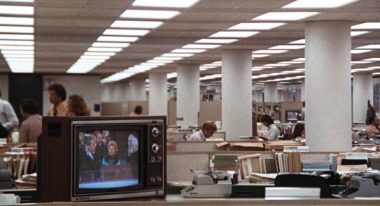
Filmmaker: I still mainly associate split diopters with Brian De Palma.
Gioulakis: For sure. I also really love the ones in All the President’s Men. Sometimes you don’t even realize it’s a split diopter until you sit there and think about it, like “Wait, that TV is in focus and the actor is also in focus. How is that possible?” There are a lot of them in that movie and they are really well hidden.
Matt Mulcahey works as a DIT in the Midwest. He also writes about film on his blog Deep FriedMovies.
